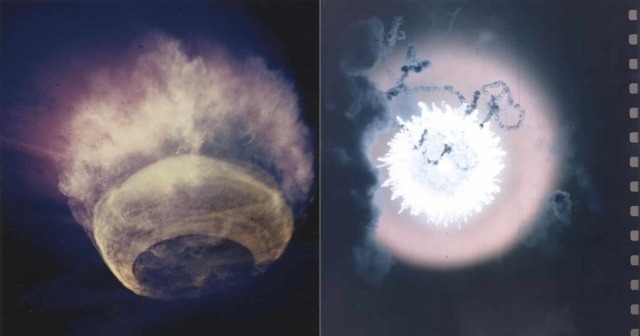Chinese military scientists have published a technique that makes it possible to massively disable satellites over a given territory using a hydrogen bomb. Moreover, this method differs from the previously proposed or even tested methods of anti-satellite warfare with nuclear weapons in the selectivity of the striking action. According to the statements of its developers, a specially organized detonation of the charge should affect only vehicles on specific orbital planes.
The proposed method involves the explosion of a warhead with a capacity of ten megatons in TNT equivalent at an altitude of 80 kilometers. In this case, air ionization will occur and gas will be released four hundred kilometers up at a speed of up to 2.3 kilometers per second. The resulting plasma cloud will become a trap for satellites flying over the site of the explosion. They will encounter a denser than usual environment and slow down a bit, and the residual radiation will damage the electronics.
The height is specially selected — it is not cosmic, but also atmospheric. If the warhead is placed above the Pocket line, then electromagnetic effects (EMR) will prevail as a result of the explosion. And the decay products of the fissile substance in the charge form radiation belts. The result will be damage to a much larger amount of equipment both on Earth and in space — it will also affect its satellites. Well, undermining below the selected point will lead to the release of the "gas trap" to a lower height. Simply put, 80 kilometers turned out to be the optimum for such a task, and the plasma cloud consisting of heavy ions will quickly descend back into the atmosphere, and the orbit will become safe again.
Starlink was chosen as the target for a reason: the Chinese military and politicians consider the "constellation" of communication satellites from SpaceX as a national threat. Firstly, they can provide internet access that is difficult to block and almost impossible to filter. And secondly, each of the satellites of the grouping represents a potential interceptor for other spacecraft. They can maneuver and are relatively inexpensive, and there are also a lot of them (more than three thousand by the fall of 2022).
Scientists from the Northwestern Institute of Nuclear Technologies (NINT) presented all their considerations and results of computer modeling in a scientific paper published in the journal Nuclear Techniques (He Jishu). The publication itself is not publicly available, so some details of the study were told by one of its authors to the online edition of the South China Morning Post.
It is worth noting that some details of modeling raise big questions, and it is not yet possible to get acquainted with the text of the work. For example, whether the risk of destruction and casualties on the surface of the Earth was taken into account when using such weapons. Thermonuclear explosions at a similar height have already been carried out — in 1958, the United States conducted Teak tests as part of Operation Hardtack. A charge with a capacity of 3.88 megatons of TNT equivalent triggered 76.8 kilometers above Johnston Atoll. Several people who watched the explosion in the open air near the epicenter felt such a heat on their skin that they could not stand it and hid for cover.
Subsequent analysis showed that the heat flow at the earth's surface reached one calorie per square centimeter. This is still not enough for burns to occur, but it is very close to the threshold value — 1.2 calories per square centimeter (according to American labor protection standards). A two and a half times more powerful explosion at a similar height risks not only causing burns to random witnesses, but even blinding them.
Finally, the most controversial point is the effectiveness of such weapons. According to Chinese scientists, the cloud of ionized gas will spread over an area of 140 thousand square kilometers (less than 0.02 percent of the Earth's surface area). That is, given the scale of near space at altitudes of at least 500 kilometers, very few satellites will fall into such a trap. If the calculations are correct and no radiation belts are formed, and the EMR will be weak. Otherwise, there is a risk of damaging a huge number of devices indiscriminately — Starlink, your own, others', allied or enemy.
Fortunately, no one is going to check the simulation, and nuclear tests in all environments (under, on and above ground) have long been prohibited. Interestingly, in addition to satellites, the authors of the work suggest using such powerful warheads against hypersonic weapons.



